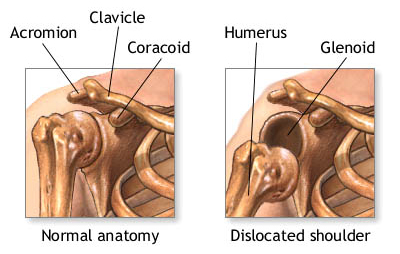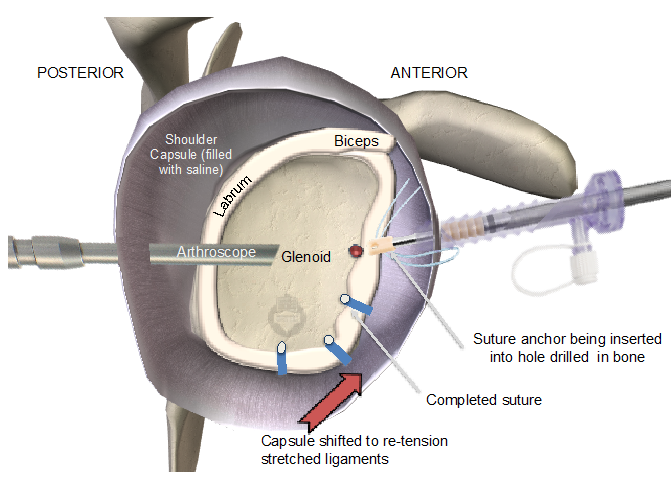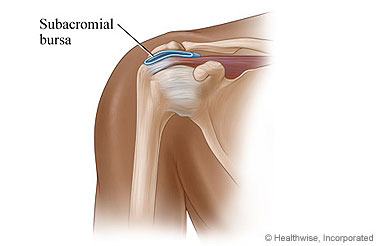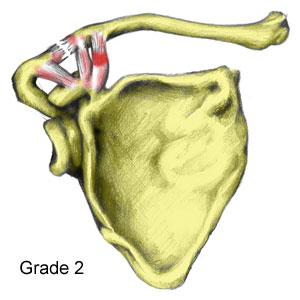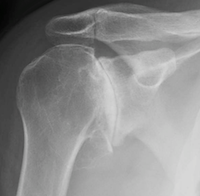Orthopaedics 360 INFO
A shoulder dislocation can occur with sporting activities, or an accident where the arm is forced into an awkward position. The most common type of dislocation is called an “anterior” dislocation, where the ball (humeral head) dislocates forwards of the soccer (glenoid). If the shoulder can be put back to the correct position by a skilled professional early, this is preferred. Sometimes, sedation is required to relax the muscles to allow a shoulder to be placed back into the correct position.
The image on the left shows what happens when a shoulder dislocates. The symptoms that follow include:
- Inability to move the shoulder
- A visible deformity around the shoulder
- Numbness or tingling in the hand and arm
- Intense pain
Once a shoulder dislocation is suspected, if it is not put in very quickly, then a trip to hospital for sedation is required. The shoulder can then be moved back to position with minimal trauma.
After a shoulder dislocation, you would normally be placed into a sling for comfort. You would not normally have to wear the sling when sleeping. Shoulder dislocations can cause fractures to the bone as well, which can cause a lot more continued pain after the shoulder is put back in. If it is a clean dislocation, where there are no bony fragments, then the shoulder pain usually improves very quickly over the first few days. Whilst waiting for an appointment and imaging (MRI is preferred), physiotherapy can help to regain range of movement safely, and is useful in reactivating the muscles in the shoulder. In the first few weeks, the following should be considered.
- Regular Panadol Osteo – This is the same as regular Panadol (Paracetamol) however the dose per tablet is slightly higher. This means that you should only take up to a maximum of 6 tablets per day rather than the usual 8 for Panadol.
- Physiotherapy to commence range of movement exercises and advise about precautions (as the shoulder is at risk of dislocating again after the first dislocation.
- A review by a trained professional to assess that your nerves are working correctly, that the shoulder is back in the correct position, and there are no fractures or other injuries.
- MRI scan is the imaging for choice, as it will show bony injury as well as soft tissue injury. This is used by an orthopaedic surgeon to decide on whether or not an operative stabilisation should be performed.
Operative Treatment
The decision to operate for a shoulder dislocation comes from multiple factors. The age of a patient, the type of dislocation, and the damaged structures based on MRI. In addition to this, the desired activities of the person is taken into consideration. In general, the younger you are, with an anterior dislocation, and a desire to return to “at risk” activities, a shoulder stabilisation is required. The type of stabilisation can be performed multiple ways. Dr Chien-Wen Liew opts to stabilise shoulders using key-hole (arthroscopic) techniques, and anchors that lie within the bone. This gives a very strong repair.
Shoulder stabilisations can be performed open or arthroscopic. Using the method above, key hole surgery can be used to stabilise the labrum after a shoulder dislocation. Special anchors are placed, that use strong sutures around the labrum, holding it in place whilst is heals.
Subacromial Bursitis
Orthopaedics 360 INFO "A Place to Learn" Shoulder bursitis is a common issue, causing difficulties with overhead movements and pain. It can come out of the blue, or due to irritation from repetitive movements. When it is suspected, there are a number of things that...
Acromioclavicular Joint Dislocation
We are currently creating fantastic new content to help our patients navigate the world of Arthritis and Sports Injury management. Please check back shortly Orthopaedics 360 INFO "A Place to Learn" An Acromioclavicular (AC) Joint disruption is fairly common, and...
Shoulder Arthritis
Shoulder arthritis limits range of motion and function. LEARN MORE
Orthopaedics 360
Orthopaedics 360
P: (08) 7099 0188
F: (08) 7099 0171
Southern Specialist Centre
Orthopaedics 360
P: (08) 7099 0188
F: (08) 7099 0171
Health @ Hindmarsh
Orthopaedics 360
P: (08) 7099 0188
F: (08) 7099 0171

